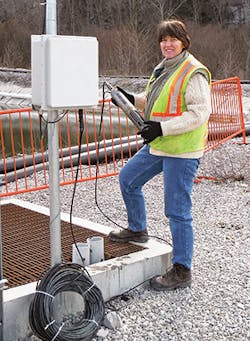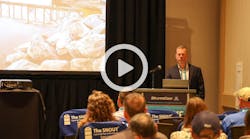Barbara Rosensteel grew up exploring Pennsylvania’s forests and streams. Born and raised in western Pennsylvania’s coal and steel belt, Rosensteel became cognizant of the many water bodies she says were “degraded by decades of abandoned mine drainage and the industrial discharges.” Today, she is an environmental consultant in wetlands, water quality, erosion and sediment control, and natural resource management.
What She Does Day to Day
As an erosion prevention and sediment control (EPSC) and water resources professional, Rosensteel helps clients identify and implement effective—and cost-effective—methods to prevent water pollution and stream degradation and educates them on why environmental controls are required. On the recent US Army Corps of Engineers Center Hill Dam remediation project, Rosensteel performed site inspections, wrote stormwater pollution prevention plan (SWPPP) revisions, and managed and conducted water-quality monitoring. She also performs wetland delineations and hydrologic determinations for other clients in Tennessee.
What Led Her to This Work
Rosensteel earned a wildlife technology degree from Penn State University and B.S. and M.S. degrees in environmental science from Rutgers University. She conducted graduate research on phosphorus dynamics in the Pompton and Passaic Rivers in New Jersey. Rosensteel then worked at Amy S. Greene Environmental Consultants in New Jersey, applying her botanical and scientific knowledge to delineate wetland boundaries and prepare permit applications. In Tennessee, she was a subcontractor on the US Department of Energy Oak Ridge Reservation and for the Tennessee Valley Authority, specializing in wetlands ecology and delineation, stream assessments, rare plant surveys, and National Environmental Policy Act work. Rosensteel’s self-directed education in nonpoint-source pollution, EPSC, and stormwater management was accomplished through workshops and seminars, reading Erosion Control and Stormwater magazines, and field observations. She studied for and obtained her CPESC certification in 2010. Her education continued through her IECA membership. Rosensteel, a former Chartiers Creek Watershed Association (PA) board member, was involved in its stream water-quality monitoring work, authored a stormwater management white paper, and received the Washington County League of Women Voters Environmental Award for her work. Rosensteel returned to Tennessee and obtained Level 1 EPSC Inspector Certification and Level 2 Design Principles for EPSC Certification from the Tennessee Department of Environment and Conservation. She says she has long been aware of “the influence of wetland functions, including nutrient cycling, sediment removal, and flood-flow alteration on nonpoint-source pollution control and reduction of stormwater impacts.” Her background in the natural and environmental sciences combined with her technical knowledge in erosion and sediment control and stormwater management gives Rosensteel a broader understanding of the sources, effects, and control of nonpoint-source contaminants and how to protect water resources while facilitating development.
What She Likes Best About Her Work
The ability to prevent water pollution and stream and aquatic system degradation is what Rosensteel enjoys about her work. Educating people, including clients, about the value of clean streams and the connections between their activities and water quality is another challenge she enjoys addressing. In principle, she says, “people know the importance of clean water and healthy aquatic ecosystems, but don’t connect their daily practices to potential stream and water quality degradation.” On the job site, Rosensteel likes for people to understand the underlying reasons for the requirements for permits and environmental controls. It boils down to “protecting and restoring water quality in the surface waters that we, and future generations, depend on to live and thrive,” she notes. Rosensteel concedes this “grandiose-sounding goal can be difficult for project managers to keep in mind in their focus on completing their project as planned, on time, and on budget.” She sees part of her job as keeping that goal in mind on behalf of her clients while helping them achieve their project goals.
Her Greatest Challenge
That which Rosensteel likes about her work also is her greatest challenge. Trying to get the message of “water quality as the basis for well-planned EPSC across to project managers who are understandably focused on getting the project done on time and on budget” can be difficult, she says. However, the spread of low-impact and sustainable development ideas offers Rosensteel optimism as “more development and construction professionals understand and internalize the water-quality message,” she says.


